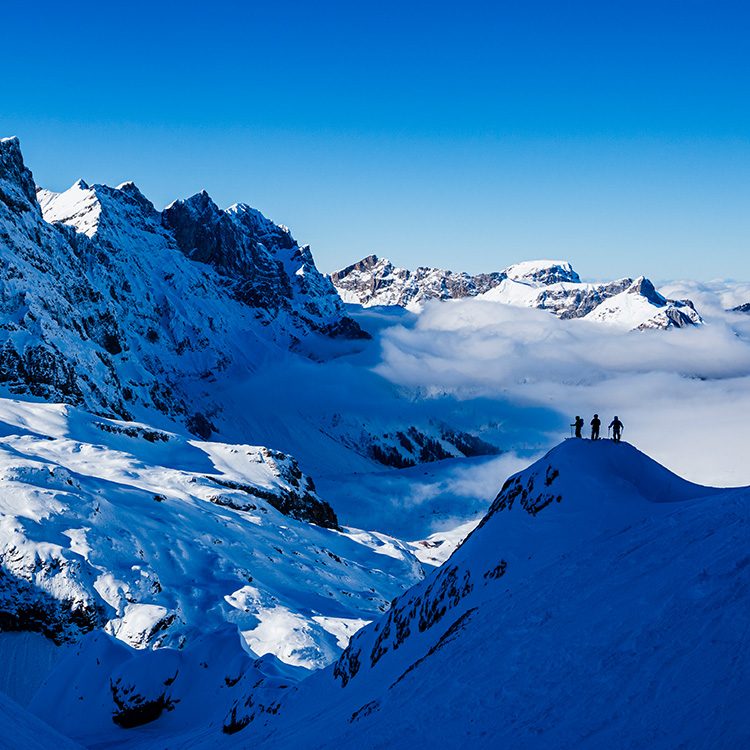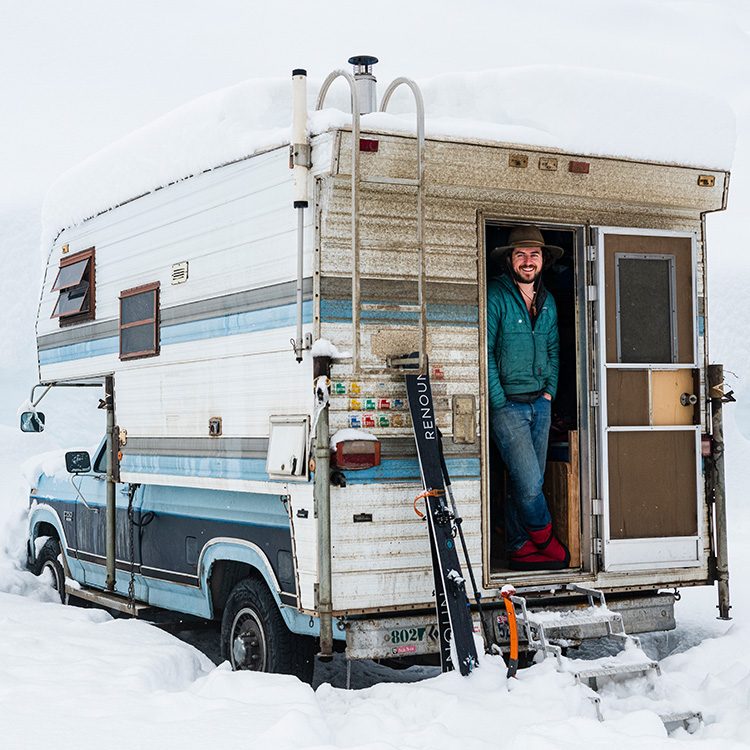Eighteen empanadas of the highest quality temporarily extinguished the searing burn of our raw feet and aching muscles.
Even so, my mind floated off, wistful as a condor, to the tin-walled ice box of a refugio, high on the second largest non-polar icefield in the world, many kilometres of complex terrain away …where I’d accidentally left my only spare pair of socks. I pondered whether the last seven kilometres of gear shlepping to the unpaved road was possible in my down booties. It wasn’t, but my mind couldn’t entertain rational ideas. Scott leaned against a stump, content as I’d ever seen him, tearing into the final of his nine savoury, deep-fried buoys of life support. We still had to haul our gear out and then pray we could hitchhike back to town, but figuratively, we were out of the woods. Finishing the last grams of our portered-in feast was a no-brainer.
Scott Becker was the only other native English speaker in Southern Patagonia that winter. A climber from Scotland, he was there to attempt a winter ascent of the highly coveted Ragni Route on the West Face of Cerro Torre with his climbing partner, Carlos Suárez. A few other international teams with similar aspirations filtered in toward the beginning of September, and, like Scott and Carlos, they were all turned back shy of the summit by frigid conditions. Few attempt such objectives; far fewer succeed.
While any and all foreign visitors are rare during the offseason, I spent three months of my North American summer as an even more distant outlier in the village. I was there to ski.
Argentina’s El Chaltén, the gateway to Los Glaciares National Park and home to Cerro Torre and Cerro Chaltén (Fitz Roy), is a particularly seasonal locale like so many of the world’s most sought-after recreational destinations. During the austral summer from December through March, thousands of hikers and sightseers descend on the small village in Southern Patagonia, hoping to glimpse towering spires and glacial lakes in the “Trekking Capital of the World.” Hundreds of the globe’s most talented alpinists arrive with granite dreams of the massif’s splitter cracks and hallowed walls. Mostly, everyone hangs around town sipping maté and speculating about the uncooperative weather.
By May, the tourists are gone, most businesses shut down for the season, and many seasonal workers leave for the offseason. Compared to the zoo-like atmosphere of high season, winter in El Chaltén is a veritable ghost town. The feral canine population significantly outnumbers daily visitors. And still, particularly among the thirty or so locals that comprise the town’s ski community, Patagonia’s tempestuous weather remains at the forefront of the conversation. Reliable snow coverage can be nonexistent in June, marginally better in July, acceptable in August, and about as good as it will get in September. But even using the term “reliable” to describe any climatological observations in Patagonia is quite the stretch. I, too, spent many days in town sipping maté and speculating about the uncooperative weather.
Yet, that inherent uncertainty is precisely what drew me to spend the more significant part of three months in El Chaltén in the heart of winter. The copious matés, mouthwatering asados, and endless ping-pong round-robins are hallmarks of the procrastinatory approach to local life that’s exceptionally difficult to find amid the hustle and grind of tourism’s high season. Even as the mercurial weather demands astute attention, its recalcitrant nature shifts focus to the other, oft-repressed side of travel experience: local culture.
On winter days when the volatile gale doesn’t allow two-planked passage into the range, the absence of tourism signals an uptick in local camaraderie and low-key celebrations in town. Free from the pressures of high season, locals find themselves with more time for family and friends, spending many long nights between el muro (the bouldering gym) and Fresco Bar — far and away the most social establishments of the offseason. Conversely, when conditions align, the skiing locals of El Chaltén have mastered a zen approach to La Escoba de Dios (“The Broom of God”) — the infamous wind. It’s just one of many challenges here. Many hours from lift service, even the mellowest ski missions are full-day backcountry affairs across complex terrain riddled with hazards. Navigating crevasses, cliff bands, wind slabs, and cornices cultivates a methodical, delicate dance with the alpine over slopes that, in high season, would be teeming with frenzied tourist activity. It’s undoubtedly the only time of year you find yourself alone at Laguna de Los Tres — a literal and figurative interpretation of the calm after the storm.
Throughout my winter immersion in El Chaltén, I made tracks with nearly every member of the local ski community. Some shared a single lap; others, a tent on multi-day traverses. But every day started with the communal passing of the maté gourd. This deep-seated cultural shared experience set the tone for the day’s objective and the relationships I’d build with the local community.
During my final week in Patagonia, my local friend, Pedro Fina, and I put that bond to the test, taking advantage of an unprecedented weather window to attempt our biggest backcountry mission of the season: four days of convoluted approaches, steep two-tooled climbing, glacier traverses, and a tick list of objectives on the edge of the Southern Patagonian Icefield. Neither of us is a particularly hard-charging downhill shredder. Still, we both possess a wealth of endurance, a curiosity to push ourselves, and an ingrained mountain sense that makes us comfortable in precarious situations. Perhaps that made us perfect ski partners: quick, efficient, a touch self-deprecative, and equally puckered on the descent of an obscure, beautiful 50-degree face on the edge of the icefield.
If weather conditions are the fickle key to unlocking big lines around El Chaltén, access is the gatekeeper to the region’s Valhalla. Innumerable unclimbed peaks dot the blank canvas of the Southern Patagonian Icefield, just beyond Fitz Roy’s skyline. But with no helicopter or fixed-wing glacier access and a talented but logistically limited human-powered search and rescue team, any ski expedition beyond the front ranges is more akin to a Karakoram mission than an Alaskan ski trip. For better or worse, you’re on foot and on your own.
I was fully aware of this as I watched Pedro drop first. Call it the benefit (or curse) of having the camera. The north face received sun early in the day and had corned up nicely. Still, I wished I’d sharpened my edges. My mountaineering setup is short. Really short. They feel like kids’ skis, sometimes. Tough to drive, easy to turn — the opposite of the old pickup truck I call home back in the States. I found myself realizing just how far out we were from any semblance of home.
Our isolation remained top of mind as I negotiated a series of cautious turns through the rollover. Then I scoped the thinnest part of the bergschrund, leaned back a little to keep my petite planks from diving, pinned it over, and let out a whoop as the angle eased and I arced bigger turns down to Pedro, who held up at the saddle. The skiing was all downhill from there, but everything was looking up.
A few days and many backcountry empanadas later, Pedro, Scott and I sat in the backyard, savouring a final asado with Pedro’s family, drinking Malbec wine and local beer under still-blue skies and a cool breeze. Above the town, wisps of serpentine cloud coiled around the spires of the massif, a sign that stronger winds had returned to the high country. Early spring sun warmed my face while my bandaged feet, in wool socks and sandals, crunched over frozen ground, relieved to be liberated from ski boots.
A few hours later, I took my final glance in the rear mirror as the snow-capped spires and quiet community disappeared. In a couple of months, tourists would flock back to the village, restaurants and hostels would reopen, and the small town would turn once more into a bustling hub of activity released by the summer’s thaw. But I was content to wait until the trails were buried under snow again, the splitter cracks filled with ice and rime, local culture percolated like water for maté, and the calm descended again. I prefer my heaven frozen over.












































